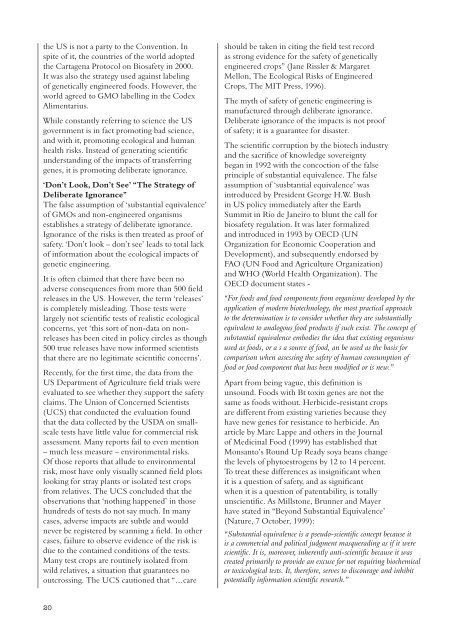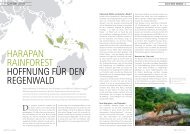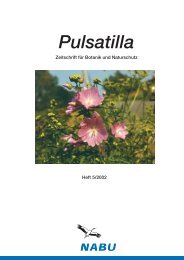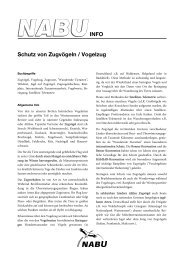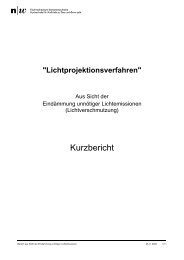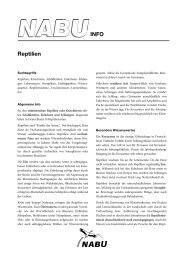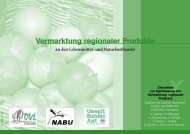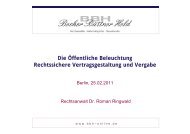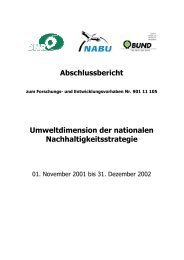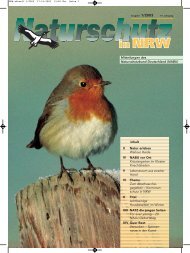Studie "The GMO-emperor has no clothes" (engl.) - Nabu
Studie "The GMO-emperor has no clothes" (engl.) - Nabu
Studie "The GMO-emperor has no clothes" (engl.) - Nabu
Create successful ePaper yourself
Turn your PDF publications into a flip-book with our unique Google optimized e-Paper software.
the US is <strong>no</strong>t a party to the Convention. In<br />
spite of it, the countries of the world adopted<br />
the Cartagena Protocol on Biosafety in 2000.<br />
It was also the strategy used against labeling<br />
of genetically engineered foods. However, the<br />
world agreed to <strong>GMO</strong> labelling in the Codex<br />
Alimentarius.<br />
While constantly referring to science the US<br />
government is in fact promoting bad science,<br />
and with it, promoting ecological and human<br />
health risks. Instead of generating scientific<br />
understanding of the impacts of transferring<br />
genes, it is promoting deliberate ig<strong>no</strong>rance.<br />
‘Don’t Look, Don’t See’ “<strong>The</strong> Strategy of<br />
Deliberate Ig<strong>no</strong>rance”<br />
<strong>The</strong> false assumption of ‘substantial equivalence’<br />
of <strong>GMO</strong>s and <strong>no</strong>n-engineered organisms<br />
establishes a strategy of deliberate ig<strong>no</strong>rance.<br />
Ig<strong>no</strong>rance of the risks is then treated as proof of<br />
safety. ‘Don’t look – don’t see’ leads to total lack<br />
of information about the ecological impacts of<br />
genetic engineering.<br />
It is often claimed that there have been <strong>no</strong><br />
adverse consequences from more than 500 field<br />
releases in the US. However, the term ‘releases’<br />
is completely misleading. Those tests were<br />
largely <strong>no</strong>t scientific tests of realistic ecological<br />
concerns, yet ‘this sort of <strong>no</strong>n-data on <strong>no</strong>nreleases<br />
<strong>has</strong> been cited in policy circles as though<br />
500 true releases have <strong>no</strong>w informed scientists<br />
that there are <strong>no</strong> legitimate scientific concerns’.<br />
Recently, for the first time, the data from the<br />
US Department of Agriculture field trials were<br />
evaluated to see whether they support the safety<br />
claims. <strong>The</strong> Union of Concerned Scientists<br />
(UCS) that conducted the evaluation found<br />
that the data collected by the USDA on smallscale<br />
tests have little value for commercial risk<br />
assessment. Many reports fail to even mention<br />
– much less measure – environmental risks.<br />
Of those reports that allude to environmental<br />
risk, most have only visually scanned field plots<br />
looking for stray plants or isolated test crops<br />
from relatives. <strong>The</strong> UCS concluded that the<br />
observations that ‘<strong>no</strong>thing happened’ in those<br />
hundreds of tests do <strong>no</strong>t say much. In many<br />
cases, adverse impacts are subtle and would<br />
never be registered by scanning a field. In other<br />
cases, failure to observe evidence of the risk is<br />
due to the contained conditions of the tests.<br />
Many test crops are routinely isolated from<br />
wild relatives, a situation that guarantees <strong>no</strong><br />
outcrossing. <strong>The</strong> UCS cautioned that “…care<br />
should be taken in citing the field test record<br />
as strong evidence for the safety of genetically<br />
engineered crops” (Jane Rissler & Margaret<br />
Mellon, <strong>The</strong> Ecological Risks of Engineered<br />
Crops, <strong>The</strong> MIT Press, 1996).<br />
<strong>The</strong> myth of safety of genetic engineering is<br />
manufactured through deliberate ig<strong>no</strong>rance.<br />
Deliberate ig<strong>no</strong>rance of the impacts is <strong>no</strong>t proof<br />
of safety; it is a guarantee for disaster.<br />
<strong>The</strong> scientific corruption by the biotech industry<br />
and the sacrifice of k<strong>no</strong>wledge sovereignty<br />
began in 1992 with the concoction of the false<br />
principle of substantial equivalence. <strong>The</strong> false<br />
assumption of ‘susbtantial equivalence’ was<br />
introduced by President George H.W. Bush<br />
in US policy immediately after the Earth<br />
Summit in Rio de Janeiro to blunt the call for<br />
biosafety regulation. It was later formalized<br />
and introduced in 1993 by OECD (UN<br />
Organization for Eco<strong>no</strong>mic Cooperation and<br />
Development), and subsequently endorsed by<br />
FAO (UN Food and Agriculture Organization)<br />
and WHO (World Health Organization). <strong>The</strong><br />
OECD document states -<br />
“For foods and food components from organisms developed by the<br />
application of modern biotech<strong>no</strong>logy, the most practical approach<br />
to the determination is to consider whether they are substantially<br />
equivalent to analogous food products if such exist. <strong>The</strong> concept of<br />
substantial equivalence embodies the idea that existing organisms<br />
used as foods, or a s a source of food, an be used as the basis for<br />
comparison when assessing the safety of human consumption of<br />
food or food component that <strong>has</strong> been modified or is new.”<br />
Apart from being vague, this definition is<br />
unsound. Foods with Bt toxin genes are <strong>no</strong>t the<br />
same as foods without. Herbicide-resistant crops<br />
are different from existing varieties because they<br />
have new genes for resistance to herbicide. An<br />
article by Marc Lappe and others in the Journal<br />
of Medicinal Food (1999) <strong>has</strong> established that<br />
Monsanto’s Round Up Ready soya beans change<br />
the levels of phytoestrogens by 12 to 14 percent.<br />
To treat these differences as insignificant when<br />
it is a question of safety, and as significant<br />
when it is a question of patentability, is totally<br />
unscientific. As Millstone, Brunner and Mayer<br />
have stated in “Beyond Substantial Equivalence’<br />
(Nature, 7 October, 1999):<br />
“Substantial equivalence is a pseudo-scientific concept because it<br />
is a commercial and political judgment masquerading as if it were<br />
scientific. It is, moreover, inherently anti-scientific because it was<br />
created primarily to provide an excuse for <strong>no</strong>t requiring biochemical<br />
or toxicological tests. It, therefore, serves to discourage and inhibit<br />
potentially information scientific research.”<br />
20


